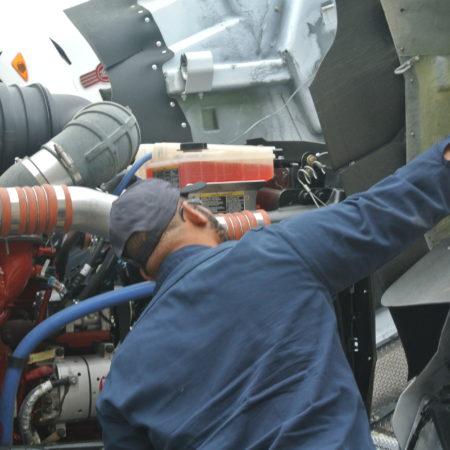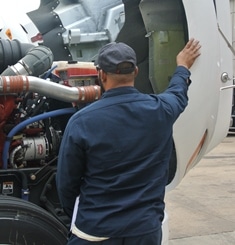By Gordon Larsen and Bill Marchetti, NGVi Technical Instructors
 In NGVi’s work training heavy-duty natural gas vehicle technicians, the number one problem they report is diagnosing low power conditions. When a Cummins-powered heavy-duty natural gas vehicle is brought into the maintenance facility with a complaint of low power, the technician wants to diagnose and repair the problem as quickly as possible. But even an experienced diesel technician can have difficulty with natural gas engines because they are different—significantly different—than their diesel counterparts.
In NGVi’s work training heavy-duty natural gas vehicle technicians, the number one problem they report is diagnosing low power conditions. When a Cummins-powered heavy-duty natural gas vehicle is brought into the maintenance facility with a complaint of low power, the technician wants to diagnose and repair the problem as quickly as possible. But even an experienced diesel technician can have difficulty with natural gas engines because they are different—significantly different—than their diesel counterparts.
As a general rule, both the Cummins ISL G and ISX12 G engines use significantly different technology than today’s comparable diesel engines. That’s not a bad thing—but it does mean that technicians need to have a full understanding of the systems and the fault code based diagnostic constraints for these engines, as well as how both the fuel and the fuel system can affect performance.
A quick comparison of natural gas heavy-duty engines to diesel engines illustrates this point. Unlike diesel engines, Cummins natural gas engines have two controllers—the electronic control module (ECM), which diesel engines have and the ignition control module (ICM), which diesel engines do not have. In addition, natural gas engines have different sensors than diesel engines. Natural gas engines may have up to 17 sensors—16 being analog sensors and only one being a CAN-networked digital sensor. Most of these analog sensors send a voltage signal to the ECM. The voltage signals are either resistance applied to a reference voltage or a direct voltage.
There are 10 actuators on Cummins natural gas engines. In this configuration, seven actuators are electro-mechanical and can send indirect trouble codes. The other two are fully mechanical actuators which send no codes.
There are three mechanical devices on Cummins natural gas engines—the boost line, the Wastegate actuator and the low pressure regulator—and none of these devices send trouble codes.
It is the complexity of the engines themselves, the uniqueness of the components and the number of components that do not send pinpoint direct component fault codes, that can make diagnosing low power a challenge. Some problems—like Code 1861 Lean Condition—will set a general code, but the technician needs to investigate a number of potential sources before he or she identifies the specific source. Other problems won’t set a fault code at all.

Some turbo failures, like boost pressure sensor, turbocharge turbine intake temperature sensor and the turbo intake humidity/pressure temperature sensors, will set fault codes. Those that do not set codes are more problematic, including turbocharger failure, turbocharger Wastegate failures and turbo boost line failure. One potential problem that is often overlooked is Wastegate failures, and there are several causes that must be investigated.
Ignition coil, coil extension, or plug failures can cause an engine to misfire and lose power. The ECM diagnostics will set misfire codes but do not pinpoint the exact component that has failed.

Mechanical failures can also be a cause of low power in heavy-duty natural gas engines. The valve lash maintenance at the recommended intervals is critical to engine life and performance.
As with any unfamiliar technology, training is the key. When technicians know the unique natural gas engine components and fuel characteristics, as well as where to start to diagnose problems even when there’s no specific code, they become more proficient at their jobs…vehicle downtime is reduced…and maintenance costs are decreased.
____________
NGVi’s Heavy-Duty NGV Maintenance and Diagnostics Training is the only ASE CASE Accredited technician training that covers both the fuel system AND the engines. To learn more, click here.


